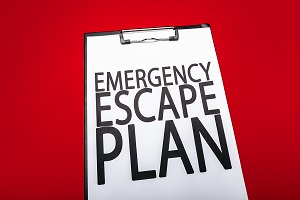
In Case of Fire, Does Your Family Have an Escape Plan? It’s 3:00 in the morning and you’re suddenly awakened by the blood curdling screams of a family member yelling, “Fire!” Now the clock is ticking, and you may have less than two minutes to escape.Do you know what to do? It’s one of the most frightening scenarios a homeowner can face.And yet, a shocking number of people are unprepared.
According to the American Red Cross, only 26 percent of families have developed and rehearsed a fire escape plan.That means only about one in three families actually knows what to do in that situation.That’s tragic.
What’s even more tragic are the deaths that could be prevented with better preparation.From 2012 to 2016, there were an average of 2,560 civilian fire deaths in home structure fires every year according to the National Fire Protection Association (NFPA).On average, seven people died in U.S.
home fires every day during that time period.Your ability to escape a fire depends on two things: working smoke alarms and an escape plan.First order of business – regularly inspect your home for fire hazards.
Also, make sure your home has working smoke alarms inside every sleeping room and outside each separate sleeping area.You should install alarms on every level of your home, and they should be interconnected so they all sound together.Regularly test each alarm to make sure they’re all working properly.
Next, you’ll want a fire escape plan.It isn’t difficult, and it’s worth taking the time to do it.Here’s an easy 7-step process to create an effective fire escape plan for your household: Map your home, showing where all doors and windows are located.
Walk through every room and, wherever possible, identify two ways out of each room.Make sure all windows and doors are working properly.Keep your escape routes clear.
You don’t want to be stumbling over items blocking your escape routes in the middle of the night or through a cloud of smoke.Keeping escape routes clear saves lives.Pick a safe spot outside your home for everyone to meet once they have escaped.
A neighbor's house, a mailbox, or a light post are possible choices.Make sure your safe spot is marked on your escape plan.Prominently display your house number so it can be easily seen from the street by firefighters.
Make sure it’s not blocked by trees, shrubs, or other obstacles.Regularly review your escape plan with everyone in your home.If you have babies, older adults, or family members with mobility issues, make sure somebody is assigned to help those people in an emergency.
Practice your plan during the day and at night to familiarize everyone with executing the plan in both scenarios.Ideally, you should run through the plan at least twice a year to keep it fresh in everyone’s mind.Want more information? Here are some helpful resources: Part of your fire survival plan includes making sure your home and belongings are financially protected in case you lose everything.
You should review your coverage limits at least once a year.Want to make sure you’re covered? Contact the personal insurance team at BNC Agency today.
Publisher: Normal for Business








